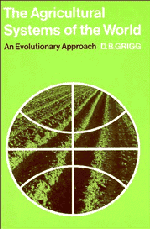4 - Technical and economic changes in agriculture
Published online by Cambridge University Press: 10 March 2010
Summary
Although certain types of agriculture have an ancestry which can be traced back to the Neolithic, others are a product of the profound economic, technical and demographic changes which have taken place since the late eighteenth century. Thus although dairying, ranching and large-scale grain production can be traced well back into agricultural history, their modern forms date only from the last hundred years.
Of greatest significance has been the growth of world population (Table 1). Until the seventeenth century world population had increased very slowly, but from then onwards it accelerated in nearly every part of t'he world. Until 1920 the rate of increase was highest in Europe and the areas of European settlement overseas; since 1920 mortality rates have declined in Africa, Asia and Latin America, and the rate of increase in these regions now not only exceeds that in the European-settled areas, but exceeds the rate at which they increased in the nineteenth century. One consequence has been a great increase in the cultivated area since the middle of the nineteenth century (Table 4), not only in the established agricultural civilisations of Europe, India and East Asia but in the hitherto sparsely settled areas of Russia, North America, Argentina, Australia, New Zealand, South Africa and Manchuria. Except in the latter area the colonisation of these areas was undertaken by people who migrated from Europe. The flow of European migrants abroad – mainly to the Americas arid South Africa – was small until the nineteenth century. But between 1850 and 1960 over 60 000 000 left Europe (Table 5).
- Type
- Chapter
- Information
- The Agricultural Systems of the WorldAn Evolutionary Approach, pp. 45 - 56Publisher: Cambridge University PressPrint publication year: 1974

